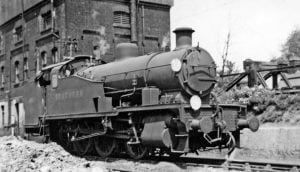0-8-0 Tanks designed by Maunsell for heavy freight trains on the Southern Railway. These large tanks are the basis for this week’s Lost Class article.
SR Z Class
By the late 1920s there was a growing need for a large freight engine. The Urie’s G16 class 4-8-0 had a few design features that Maunsell disliked, opting to build a new class of locomotives. Such engines would mainly be used on shunting duties, both passenger and freight stock. This would mean the locomotives would need a wheel base capable of handling tight radius curves and also maintain steam reserves over long periods due to the nature of shunting work.
Ashford Works was allocated the design work. They incorporated a 0-8-0 wheel arrangement, 1,500-gallon water tanks and 3-ton coal capacity. The basic dimensions for both engines as built include: 0-8-0 wheel arrangement (coupled wheels – 4 foot (ft) 8 inch (in), boiler pressed at 180 lbf/in2, three cylinders (one inside and two outside) (16 in diameter and 28 in stroke) worked by Walschaerts valve gearing on the outside cylinders and customer built valve gearing on the inside cylinder, total weight came in at 71 long tons (engine only) and a tractive effort of 29,376 lbf.
Construction was planned to take place at Ashford but due to a sudden increase in workload, Brighton Works took over the production of the class. The class was turned out between March and September 1929.
Performance in Service
The class became an instant success when entering traffic. They were based at a few locations, these being Hither Green, Norwood Junction, Exmouth Junction and Nine Elms. Crews reported back positive views on the engines. The only minor issues were the length of the frame over the trailing and leading coupled wheels. On tighter curves, the buffers would stick out a fair distance which could potentially lead to accidents. This issue is highlighted by Nine Elms.
In World War 2, three engines became part of the War Department stock. This saw the locomotives move to Scotland to haul heavy freight trains. They were chosen due to their good performance. The engines didn’t spend more than six months on these services, as crews in the North struggled to adapt their driving techniques to the unique valve gearing design featured in the Z class.
Decline and Withdrawal

Further engines had been planned to be produced, but the Great Depression of the 1930s saw a decrease in freight traffic, meaning there was no need for more locomotives. When traffic picked up again, the new demand was met by diesel traction. The 1950s saw more and more types of diesel entering traffic, displacing the Z class to other depots across the Southern Region of BR, where they were allocated banking duties. The end of the class came when the parts of the Western Section of the Southern Region became part of the Western Region. With this change, Ex-Great Western Railway Pannier tanks took over these duties. This left the Z class to be withdrawn and all eight engines to be scrapped.
Preservation
Currently, there is only one full new build project (More information on this project can be found here for a Southern Railway or Pre-Grouping design, with there being many lost designs from the Southern Railway. Although the Z class proved capable locomotives, with many of their attributes being suited to Heritage Railway, it’s unlikely we will see a project formed to build one in the near future.
We hope you have enjoyed this week’s article of the SR Z class. We hope to be back next Wednesday to bring you another Lost Class article.
- Visit the RailAdvent news homepage
For the latest railway news - Visit the RailAdvent Shop
For railway related goodies! - Visit LocoStop – Our New Social Network
Come and share your photo’s and video’s, join the discussion.
Find out what others are sharing